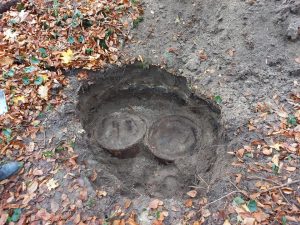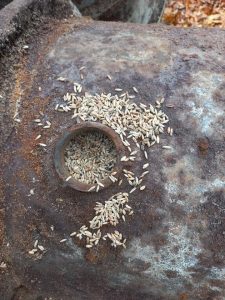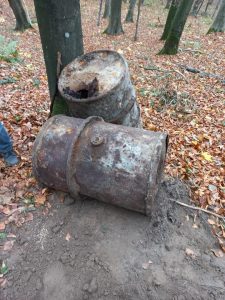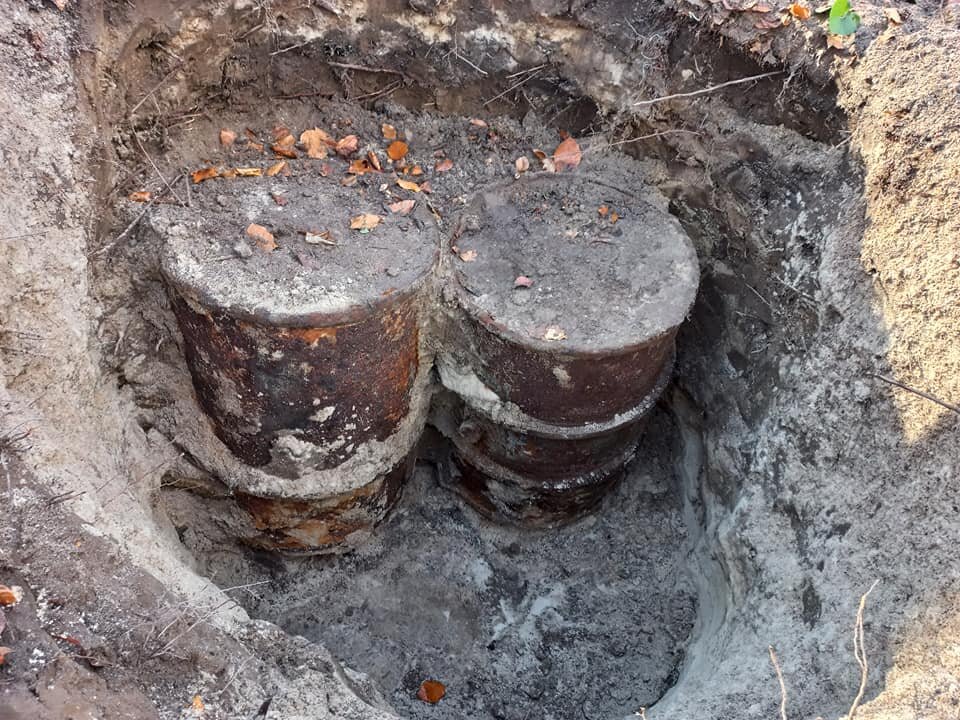One drum is intact; the other is slightly damaged. The photos were published on their Facebook page.

The news was subsequently announced on FB by Mykola Bandrivsky, chairman of the archeological commission at the Shevchenko Scientific Society in Europe, head of the Department of the Institute of Religious Studies at the Museum of the History of Religion in Lviv.
“This is yet another – and quite unexpected find – by some “black diggers” in the forest near Peremyshliany in Lviv Oblast. These two drums are probably silent witnesses of the dreadful famine that befell parts of Halychyna (Galicia) in 1947 (my mother and grandmother told me about this period).
A question remains – why was this grain not used by the person, or persons, who buried it? We’ll probably never know the truth.”
Mykola Bandrivsky adds that such finds are important as they are living reminders of the past, so that we do not forget those terrifying post-war years under the communist regime.
Followers and experts have raised several hypotheses concerning this find:
- Ukrainian peasants hid the grain from the Soviet authorities during the famine of 1946-47;
- The grain was stored by/for the partisans of the Ukrainian Insurgent Army (UPA);
- The peasants hid the grain from the collective farms (kolkhozes).

Most Ukraine followers have heard of or read about Stalin’s Great Famine of 1933, commonly known as the Holodomor. But, did you know that post-war Ukraine suffered yet another famine in 1946-47? In fact, there were three major famines in Ukraine – 1921-1922, 1932-1933, 1946-1947- but very little is known about the last. But, historians tend to agree that a combination of factors was responsible for mass starvation in the Soviet Ukrainian countryside in 1946-47. First, World War II caused a decrease in production on the collective farms. Furthermore, when the war ended, many peasant soldiers refused to return to the farms and chose to live in the more prosperous, industrialized cities. Second, a severe drought hit Moldavia, most of Ukraine and some parts of the Volga region in Russia. But, the Soviet government refused to lower quotas on grain and other food products, while Stalin cynically connected this famine to manifestations of “Ukrainian bourgeois nationalism”. Moreover, the Soviet authorities threatened local officials for hoarding or sabotage if they failed to meet the quotas. And finally, a substantial amount of requisitioned grain and food was exported to feed the Soviet regimes in Poland, Czechoslovakia and Bulgaria. Third. The Decree of September 19, 1946 “On Measures to Liquidate Breaches in the [Kolkhoz] Statute” required peasants to return all kolkhoz lands that had been formerly used for private and family purposes. It also enforced compulsory delivery of grain quotas to the state and enhanced the power of Soviet procurement bodies. The famine was not widespread in Western Ukraine, newly annexed by Moscow in 1944, because the new Soviet authorities met with strong resistance from West-Ukrainian peasants in implementing collectivization. Moreover, the Ukrainian Insurgent Army (UPA) was still a force to be reckoned with in most parts of Halychyna (Galicia): these underground partisans defended the villages and farmers and mounted resistance to the export of grain. However, the famine did reach Chernivtsi and Stanislaviv regions (today’s Ivano-Frankivsk Oblast) and there were severe shortages of food in the major cities of western Ukraine In other regions of Ukraine, the famine was devastating. Consequently, many peasant families from the central and eastern regions traveled to western Ukraine in search of food, and in the summer of 1946, trains going westward were crammed with sick and starving people. The UPA appealed to local peasants to help the hungry who were seeking food and help. On the other side, the Soviet authorities introduced severe restrictions, forbidding western Ukrainian peasants to sell food to newcomers and spreading rumours of epidemics and poisoned food in the western oblasts. The Soviet regime never acknowledged the 1946-1947 famine in Ukraine. Estimates of the number of people who died vary, ranging from 100,000 to over one million. The forests, plains and rivers of Ukraine teem with hidden historical treasures, artifacts and precious objects from the past. It is no wonder that local diggers take to the countryside, searching for buried and forgotten sites and carrying out illegal excavations… all in the name of profit. Some experts estimate that there are over 100,000 “black diggers” in Ukraine, people armed with metal detectors and organized into small groups that scour the Ukrainian countryside searching for profitable treasures. Historians and archeologists have regularly denounced the “black diggers” who roam the fields and “shamelessly plunder Ukrainian antiquities hidden underground”. However, it is true that these “diggers” sometimes unearth amazing and interesting objects! These are not necessarily profitable artifacts, but objects that should not be put up for sale in order to make money, such as the two drums of grain from the post-war famine period in Halychyna. All things considered, teams of “black diggers” have come up with some astounding finds: aluminum or zinc milk canisters filled with archives of regional UPA units, old postcards, photos of UPA fighters, documents and awards belonging to Soviet soldiers and officers, including MGB officers, etc. Historian Mykola Bandrivsky says that “almost every second or third month, I record reports of the discovery of such canisters in the forests of Lviv, Ternopil and Ivano-Frankivsk.” According to his calculations, from 2018 to 2021, “black diggers” unearthed about 35 milk canisters in these areas. Some of them contained documents that were transferred to the Institute of National Memory to be properly processed, some were handed over to local history museums, and some were acquired by private individuals. It should be noted that, as opposed to “black digging”, archeology is a science, whose purpose is not to hunt for expensive artifacts, but to reveal and study the secrets of the past. Hopefully, the “diggers”, who unearthed this interesting and intriguing discovery from 1946-47, will alert a responsible institution or donate the metal drums and grain to a local museum. We’ve just learnt that the diggers have handed over the metal drums discovered near the village of Chemeryntsi to the Museum of Local Folklore in Peremyshlyany. Thank you guys! Great work!
UPDATE!




